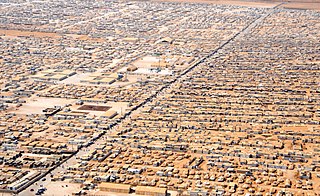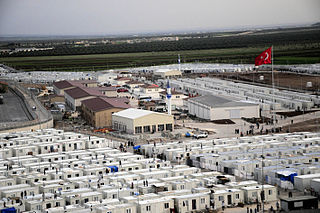Nationality is the legal status of belonging to a particular nation, defined as a group of people organized in one country, under one legal jurisdiction, or as a group of people who are united on the basis of culture.

Syria's estimated pre–Syrian Civil War 2011 population was 22 ±.5 million permanent inhabitants, which included 21,124,000 Syrians, as well as 1.3 million Iraqi refugees and over 500,000 Palestinian refugees. The war makes an accurate count of the Syrian population difficult, as the numbers of Syrian refugees, internally displaced Syrians and casualty numbers are in flux. The CIA World Factbook showed an estimated 20.4m people as of July 2021. Of the pre-war population, six million are refugees outside the country, seven million are internally displaced, three million live in rebel-held territory, and two million live in the Kurdish-ruled Autonomous Administration of North and East Syria.
The Office of the United Nations High Commissioner for Refugees (UNHCR) is a United Nations agency mandated to aid and protect refugees, forcibly displaced communities, and stateless people, and to assist in their voluntary repatriation, local integration or resettlement to a third country. It is headquartered in Geneva, Switzerland, with over 18,879 staff working in 138 countries as of 2020.

Dadaab is a semi-arid town in Garissa County, Kenya. It is the site of a UNHCR base hosting 302,805 registered refugees and asylum seekers as of 31 October 2023, in four camps, making it one of the largest in the world behind Kutupalong refugee camp. The centre is run by the United Nations High Commissioner for Refugees, and its operations are financed by foreign donors. In 2013, UNHCR, the governments of Kenya and Somalia signed a tripartite agreement facilitating the repatriation of Somali refugees at the complex.
Kebri Beyah is a city and woreda in Somali Region, Ethiopia. Part of the Kebri Beyah is bordered on the south by the Degehabur Zone, on the southwest by the Fiq Zone, on the northwest by Gursum, on the north by Jijiga and Awbare, on the northeast by Somaliland, and on the east by Harshin. The City administrative center is Kebri Beyah City.
October 1992 Turkish attack on Hakurk Camp was a cross-border operation by the Turkish Armed Forces into northern Iraq between 12 October and 1 November 1992, that was conducted during the October 1992 Turkish incursion into Northern Iraq, against the Kurdistan Workers Party (PKK) which is listed as a terrorist organization internationally by a number of states and organizations, including the United States, NATO and the EU. More than 70,000 people have been killed in the Kurdish–Turkish conflict since 1984.

The Iraqi diaspora refers to native Iraqis who have left for other countries as emigrants or refugees, and is now one of the largest in modern times, being described by the UN as a "humanitarian crisis" caused by the 1991 Gulf War and 2003 invasion of Iraq and by the ensuing war.
Since the late 1970s until the present, Iraq has witnessed numerous waves of refugees and emigrants due to significant events in its modern history. These events have led to the displacement of millions of Iraqis. These include over three decades of repression, periodic violent attacks, and massacres targeting the Kurdish population in the north and the Shi'a in the south, all carried out by Saddam Hussein's regime. Other factors include the Iran-Iraq War (1980-1988), the Gulf War of 1991, the prolonged economic sanctions until the overthrow of Saddam Hussein, and the 2003 US-led invasion of Iraq.

Iraqi nationality is transmitted by one's parents.
Refugees of the Syrian civil war are citizens and permanent residents of Syria who have fled the country throughout the Syrian civil war. The pre-war population of the Syrian Arab Republic was estimated at 22 million (2017), including permanent residents. Of that number, the United Nations (UN) identified 13.5 million (2016) as displaced persons, requiring humanitarian assistance. Of these, since the start of the Syrian civil war in 2011 more than six million (2016) were internally displaced, and around five million (2016) had crossed into other countries, seeking asylum or placed in Syrian refugee camps worldwide. It is often described as one of the largest refugee crises in history.

Crisis mapping is the real-time gathering, display and analysis of data during a crisis, usually a natural disaster or social/political conflict. Crisis mapping projects usually allows large numbers of people, including the public and crisis responders, to contribute information either remotely or from the site of the crisis. One benefit of the crisis mapping method over others is that it can increase situational awareness, since the public can report information and improve data management.

Syrian refugee camp and shelters are temporary settlements built to receive internally displaced people and refugees of the Syrian Civil War. Of the estimated 7 million persons displaced within Syria, only a small minority live in camps or collective shelters. Similarly, of the 8 million refugees, only about 10 percent live in refugee camps, with the vast majority living in both urban and rural areas of neighboring countries. Beside Syrians, they include Iraqis, Palestinians, Kurds, Yazidis, individuals from Somalia, and a minority of those who fled the Yemeni and Sudanese civil wars.

Ayn Issa is a town in the Tell Abyad District of Raqqa Governorate in Syria. It is located halfway between the Syria–Turkey border town of Tell Abyad and the regional capital Raqqa. Through the city runs the M4 highway connecting Aleppo with the Hasakah Governorate.
South Sudanese refugees are persons originating from the African country of South Sudan, but seeking refuge outside the borders of their native country. The world's youngest independent country has a recent and troubled history of prolonged conflicts and ecosystem mismanagement such as overlogging, which has led to desertification. These forces have resulted not only in violence and famine, but also the forced migration of large numbers of the population, both inside and outside the country's borders. South Sudan was cited as the largest refugee crisis in 2016, being the world's third largest, followed by Syria and Afghanistan. As of 2022, the UNHCR estimated that there were 2.4 million refugees under its mandate originating from South Sudan, making the country the fifth largest source of refugees.
The Syrian Vulnerable Person Resettlement Programme, sometimes referred to as a RelocationScheme, is a programme of the United Kingdom government that plans to resettle 20 000 Syrian refugees from refugee camps in Jordan, Lebanon, Iraq, Egypt and Turkey over the period from September 2015 to May 2020. It was first announced in January 2014 and in September 2015 the expansion to 20,000 refugees was made. It is run in partnership between the UK Home Office, the Department for International Development, the Ministry of Housing, Communities and Local Government and NGOs such as Refugee Action. Only 2,659 Syrian refugees were resettled through the programme by the end of June 2016. The National Audit Office estimated the Programme's cost at £1,112 million. Syrians are only granted 5 years humanitarian protection and not indefinite leave to remain.

Refugees of the Syrian civil war in Turkey are the Syrian refugees fleeing the Syrian civil war. The Republic of Turkey hosts over 3.7 million registered refugees.

The Turkish migrant crisis, sometimes referred to as the Turkish refugee crisis, was a period during the 2010s characterised by a high number of people migrating to Turkey. Turkey received the highest number of registered refugees of any country or territory each year from 2014 to 2019, and had the world's largest refugee population according to the United Nations High Commissioner for Refugees (UNHCR). The majority were refugees of the Syrian Civil War, numbering 3.6 million as of June 2020. In 2018, the UNHCR reported that Turkey hosted 63.4% of all "registered Syrian refugees."
During the occupation of Iraq, Palestinians who lived in the country became the targets of violence, killings and scapegoating by Shia militant groups.
The Refugee Consortium of Kenya also called Haki House, is a non-governmental organization (NGO) founded in 1998 by Ms. Abi Gitari to address the increasingly complex and deteriorating refugee situation in Kenya, the Great Lakes, and the Horn of Africa Region. RCK was founded by Ms. Abi Gitari and Justice Mbogholi Msagha as a co-founder. Eunice Ndonga-Githinji is its current Executive Director.







